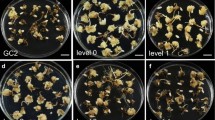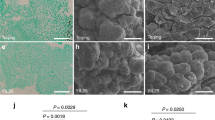Abstract
Being the crucial step for rice transgenic manipulation, callus culture from mature seeds is severely restricted by browning of induced calli, especially in the case of indica (Oryza Sativa L.) rice. Once this browning occurs, the callus will die and no embryonic calli can be obtained for regeneration. Here we report an induction procedure that overcomes callus browning was found. To clarify the inheritance pattern of callus browning, two reciprocal crosses F2 and two backcrosses BC1 were made between indica cultivar inbred lines 93-11 and YueTaiB (YTB) which produced normal and browning respectively in the same induction medium. The ratio of browning to normal in the reciprocal F2 and backcross (BC1) populations tested was approximately 1:3 and 1:1, respectively, these results indicate that callus browning is controlled by one single chromosomal locus which is tentatively named Ic1 (Induced callus 1). The genetic mapping of this locus was carried out using microsatellite markers (SSR) in a 216 extremely browning F2 seed callus. The analysis of genetic linkage indicated that one single locus that mapped to chromosome 1 was correlated to callus browning, and the closest marker in this study was mapped within 1.9 cM from the target locus.


Similar content being viewed by others
References
Abe T, Futsuhara Y (1991) Diallel analysis of callus growth and plant regeneration in rice seed-callus. Jpn J Genet 66:129–140
Asuka N, Motoyuki A, Shaoyang L (2005) Isolation of a rice regeneration quantitative trait loci gene and its application to transformation systems. PNAS 102:11940–11944
Barret P, Brinkman M, Dufour P, Murigneux A, Beckert M (2004) Identification of candidate genes for in vitro androgenesis induction in maize. Theor Appl Genet 109:1660–1668
Ben Amer IM, Korzun V, Worland AJ, Borner A (1997) Genetic mapping of QTLs controlling tissue-culture response on chromosome 2B of wheat (Triticum aestivum L.) in relation to major genes and RFLP markers Theor Appl Genet 94:1047–1052
Block R, Lankes C (1995) Reasons for tissue brown of explants of the apple rootstock M9 during in vitro establish meant. J Gartenbauwis-senschaft. 60(6):276-279
Choi YE, Kim JW, Soh WY (1997) Somatic embryogenesis and plant regeneration from suspension cultures of Acanthonax koreanum Nakai. Plant Cell Rep 17:84–88
Chu CC, Wang CC, Sun CS (1975) Establishment of an efficient medium for anther culture of rice through comparative experiments on the nitrogen sources. Sci Sin 18:659–668
Daigen M, Kawakami O, Nagasawa Y (2000) Efficient anther culture method of the Japonica rice cultivar Koshihikari. Breed Sci 50:197–202
Gamborg OL, Miller RA, Ojima K (1968) Nutrient requirements of suspension culture of soybean roots cells. Exp Cell Res 50:150–158
Hanna L, Lea Erja T, Anja H (2000) Changes in cellular structures and enzymatic activities during brown of Scots pine callus derived from mature buds. Tree Physiol 20:467–475
Hiei Y, Komari T, Kubo T (1997) Transformation of rice mediated by Agrobacterium tumefaciens. Plant Mol Biol 35:205–218
Hoque ME, Mansfield JW (2004) Effect of genotype and explant age on callus induction and subsequent plant regeneration from root-derived callus of Indica rice genotypes. Plant Cell Tiss Org Cult.78:217–223
Huang QY, He YQ, Jing RC, Zhu RS, Zhu YG (2000) Mapping of the nuclear fertility restorer gene for HL CMS in rice using microsatellite markers. Chinese Sci Bull 45:430–432
Inoue M, Maeda E (1980) Thiamine as a factor of organ formation in rice callus cultures. Jap J Crop Science 49:1–7
Kawata S, Ishihara A (1968) The regeneration of rice plant (Oryza sativa L.) in the callus derived from the seminal root. Proc Jpn Acad 55:549–553
Kenjirou O (2003) Enhancement of regeneration of rice (Oryza sativa L) calli by integration of the gene involved in regeneration ability of the callus. Plant Sci 165:395–402
Laukkanen H, Haggman H, Kontunen-Soppela S, Hohtola A (1999) Tissue browning of in vitro cultures of Scots pine: role of peroxidase and polyphenol oxidase. Physiol Plant 106:337–343
Lchihasshi S, Karo S (1977) Studies on clonal propagation of cattleya tissue method. II. Browning of cattleya. J Jap Soc Hort Sci 46:325–330
Lincoln S, Daly M, Lander E (1992) Constructing genetic maps with MAPMAKER/EXP. 3.0. Whitehead Institute Technical Report 3rd edn, Whitehead Institute for Biochemical Research, MA
Maeda E (1968) Subculture and organ formation in the callus derived from rice embryos in vitro. Proc Crop Sci Soc Jpn 37:51–58
Mano Y, Komatsuda T (2002) Identification of QTLs controlling tissue-culture traits in barley (Hordeum vulgare L.). Theor Appl Genet 105:708–715
McCouch SR, Teytelman L, Xu Y (2002) Development and mapping of 2240 new SSR markers for rice (Oryza sativa L). DNA research l9:199–207
Mohamed SV, Jayabalan N (1996) A protocol for horsegram (macrotyloma uniflrtum (Lam) verdc) callus inducation. Israel J Plant Sci 44(2–3):143–145
Murashige T, Skoog F (1962) A revised medium for rapid growth and bioassays with tobacco cultures. Plant Physiol 15:473–493
Nabors MW, Heysers JW, Dykes TA, Demtt KJ (1983) Long-duration, high-frequency regeneration form cereal tissue culture. Planta 157:385–391
Niizeki H, Oono K (1968) Induction of haploid rice plants from anther culture. Proc Jpn Acad 44:554–557
Ogawa T, Fukuoka H, Yano H, Ohkawa Y (1999) Relationships between nitrite reductase activity and genotype-dependent callus growth in rice cell cultures. Plant Cell Rep 18:576–581
Patnaik J, Sahoo S, Debata BK (1997) Somatic embryogenesis and plantlet regeneration from cell suspension cultures of palmarosa grass (Cymbopogon martini). Plant Cell Rep 16:430–434
Pindel A, Miczynski K (1996) Regeneration of cymbidium orchids from leaf and root explants. Floria Horticulture 8(2):95–105
Prathanturarug S, Schaffner W, Berger BK (1996) In vitro propagation of Thai medicinal plant andrographis paniculata Nees, Proc. Inter. Symp. Breeding research on medicinal and aromatic plants, Quedlinburg Germany 30 Junc-4 July.Beitrage and Zuchtungaforschung fur Zuchtungsforchung an Kulturpflansen 2(1):304–306
Ruigni E (1984) In vitro propagation of some olive (Olea etgropaea L.) cultivars with different root ability and medium development using analytical data from developing shoots and embryos. J Sci Hortic 10(4):339–345
Schiantarelli EA, De la Pena, Candela M (2001) Use of recombinant inbred lines (RILs) to identify, locate and map major genes and quantitative trait loci involved with in vitro regeneration ability in Arabidopsis thaliana. Theor Appl Genet 102: 335–341
Taguchi-Shiobara F, Yamamoto T, Yano M, Oka S (2006) Mapping QTLs that control the performance of rice tissue culture and evaluation of derived near-isogenic lines. Theor Appl Genet 112:968–976
Takeuchi Y, Abe T, Sasahara T (2000) Influencing Shoot Regeneration from Mature Seed-Derived Calli in Rice. Crop Science 40:245–247
Tamura S (1968) Shoot formation in calli originated from rice embryo. Proc Jpn Acad 44:544–548
Tatiana Boluarte-Medina, Richard E Veilleux (2002) Phenotypic characterization and bulk segregant analysis of anther culture response in two backcross families of diploid potato RAPD markers for androgenesis in potato. Plant Cell, Tissue and Organ Culture 68:277–286
Vieitez AM, Ballester A, Vieitez ML (1983) In vitro plantlet regeneration of mature chestnut. J Hotic Sci 58:457–463
XiaoXingguo, Hirsch AM (1996) Microcallus formation form leaf mesophyll protoplasts in the genus Actinidialindl. Plant Cell Rep 15(12):896–899
Yu K, Pauls K (1993) Identification of a RAPD marker associated with somatic embryogenesis in alfalfa. Plant Mol Biol 22:269–277
Acknowledgement
This work is supported by Chinese National 973 Program (Grant number: 2001CB108806) and National Nature Science Foundation of China (30270149).
Author information
Authors and Affiliations
Corresponding author
Rights and permissions
About this article
Cite this article
Li, Z., Duan, S., Kong, J. et al. A single genetic locus in chromosome 1 controls conditional browning during the induction of calli from mature seeds of Oryza sativa ssp. indica . Plant Cell Tiss Organ Cult 89, 237–245 (2007). https://doi.org/10.1007/s11240-007-9248-x
Received:
Accepted:
Published:
Issue Date:
DOI: https://doi.org/10.1007/s11240-007-9248-x




